The Ultimate Trans-Sahara & Black Africa Expedition
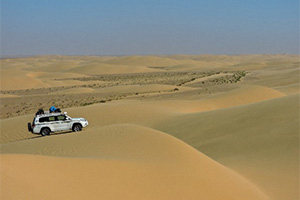
Duration: 29 days
Area: Morocco, Mauritania, Senegal, Gambia & Guinea Bissau
Style: adventurous expedition, cultural tour
Comfort Level:![]()
![]()
![]()
![]()
![]()
The Trans-Sahara & Black Africa expedition is waiting for you.
29 Days
Morocco, Western Sahara, Mauritania, Senegal, Gambia & Guinea Bissau
2019 departures :
November 15th 2019 : from Bijagos Archipelago - Dakar - Marrakech
2020 departures :
April 04th 2020 : from Bijagos Archipelago - Dakar - Marrakech
November 13th 2020 : from Marrakech - Dakar - Bijagos Archipelago
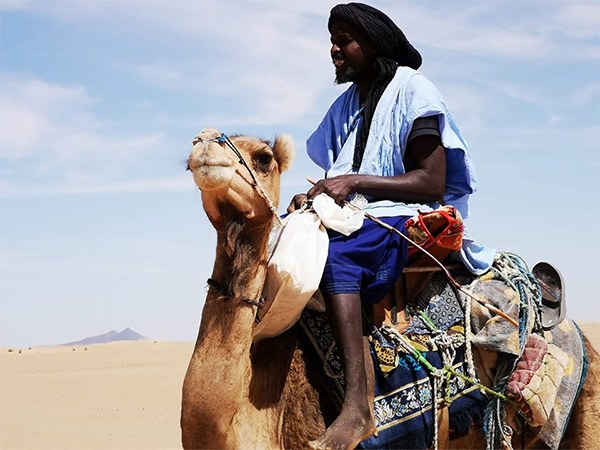
An incredible journey across unique ever-changing landscapes and eco-systems to encounter the main natural, cultural and religious “milieu” of the African continent. From the desert to the savannah and on to the forest.
CULTURE - from camel herders to fishermen, from legendary Sahrawi nomads to isolated Berber villages, from sacred forests with traditional animistic religions and tribal kings to a cosmopolitan metropolis like Dakar.
HISTORY - encounters with “timeless” people and visits of historical sites such as Marrakech, Dakhla, Chinguetti, Saint Louis, Dakar, Goré and Bolama.
NATURE - along the “uncertain border” between water and land, we follow the migratory route of birds, visit two of the richest bird sanctuaries of West Africa and admire an astonishing range of plant species.
An adventurous expedition resulting from many years of research on the field.
A journey for “real explorers”
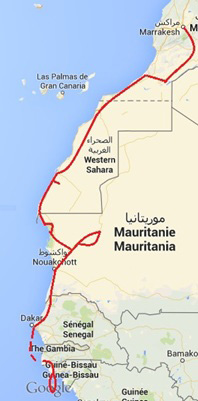
| Day 1 - 12 | Morocco and its less travelled paths |
| Day 13 - 19 | Mauritania, pure Sahara exploration combined with the visit of historic jewels |
| Day 20 - 25 | Senegal, from northern savannah to southern sacred forests |
| Day 26 - 29 | Guinea Bissau and the remote Bijagos Archipelago |
Detailed Itinerary
Day 1: Marrakech
Individual arrival.
Overnight at the comfortable Novotel **** international standard, in the heart of Marrakech.
Day 2: High Atlas
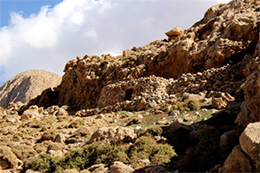 We will live the main road to discover the les frequented Berber villages in the High Atlas Range and joint the local gems diggers in quest of Amethyst, Tourmaline…. With their help we will be able to find our own gems… Our itinerary cross Tizi-n- Tichka pass at 7460 ft. In the southern side of the Atlas we will stop at Ait Benhaddou a beautiful adobe Ksar (fortified village) still partially inhabited and one of the great examples of Adobe Architecture in Morocco. Ait Benhaddou is on the ancient caravan route linking Marrakech with the Sahara. In the modern time in this Ksar has been shot many famous movies including Lawrence of Arabia, Sodom and Gomorrah, Oedipus Rex, The Sheltering Sky, The Jewels of the Nile, Jesus of Nazareth, Alexander, Gladiator, and more…
We will live the main road to discover the les frequented Berber villages in the High Atlas Range and joint the local gems diggers in quest of Amethyst, Tourmaline…. With their help we will be able to find our own gems… Our itinerary cross Tizi-n- Tichka pass at 7460 ft. In the southern side of the Atlas we will stop at Ait Benhaddou a beautiful adobe Ksar (fortified village) still partially inhabited and one of the great examples of Adobe Architecture in Morocco. Ait Benhaddou is on the ancient caravan route linking Marrakech with the Sahara. In the modern time in this Ksar has been shot many famous movies including Lawrence of Arabia, Sodom and Gomorrah, Oedipus Rex, The Sheltering Sky, The Jewels of the Nile, Jesus of Nazareth, Alexander, Gladiator, and more…
Evening arrival at Ouarzazate, large Oasis at the edge of the desert. Dinner and overnight in an international hotel.
Day 3: Secret Valleys, Cavern Dewelers and Rock Art
Early morning departure. Following a steep track from valley to valley will bring us to remote shepherd families still living permanently in caves. A highland itinerary (often at more than 6000 Ft. ) to explore the les visited region of the Djebel (mountains) Sarhro. Following a tiny track that climbs rocky valleys through a breathtaking landscape of mountains and desert our itinerary cross an arid spectacular mountain landscape: picks, tabular rocks, rare nomad tends and tiny Berber villages. Visit of an ancient rock art site. Hundreds of fine graffiti dating thousands years ago, silent witnes of peoples living in these regions before the desertification.
Arrival in the evening at Zagora Oasis, dinner and overnight at a charming hotel built in traditional local architecture, comfortable rooms and restaurant.
Day 4 & 5: Dunes
We will live Zagora to visit the oasis in the Dra river bed, a large continuous strep of luxuriant vegetation surrounded by the ochre and yellow colors of the desert. In the shade of 2.200.000 palm trees, small gardens are a green miracle in the desert. In Mhamid the Sahara adventure starts; our 4x4 will enter a region of tall dunes, the Erg Chegaga. Dinner and overnight in a comfortable fix camp, with beds, restaurant and facilities.
We will start the day driving out of any track finding our way, crossing tall ranges of dunes to reach Iriki dry salt lake. Late afternoon Arrival at Icht, a comfortable hotel in the desert; Air conditioned bungalows and tents with beds, private facilities, restaurant, swimming pool.
Day 6: Caravan Route & Ancient Fort
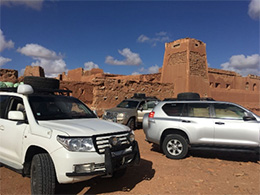 The road will bring us to Guelmim, an ancient caravan terminal. Here we will discover the remains of the ancient Trans-Sahara trade…
From this point onward, we will primarily travel along one of the most fishy coasts on earth. We will follow the “migration route” of the paleo-artic birds that migrate to winter in Africa every year during this season. Visit to a spectacular ghost military fort, which still “guards” the former borders between the French protectorate of Morocco and the Spanish Sahara. Feeling like we are on the set of an old French Foreign Legion movie. Afternoon arrival at the charming and comfortable Ksar Tafnidilt hotel, built using local material in a beautiful Saharan architecture. The hotel is managed by our friends, Guy and Magali, a French couple. Magali is a desert expert; she won the “Rally des Gazelle,” the most gruelling off-road competition reserved for female teams. Ksar Tafnidilt is a meeting point for passionate Sahara travelers; the hotel will be our base for two nights.
The road will bring us to Guelmim, an ancient caravan terminal. Here we will discover the remains of the ancient Trans-Sahara trade…
From this point onward, we will primarily travel along one of the most fishy coasts on earth. We will follow the “migration route” of the paleo-artic birds that migrate to winter in Africa every year during this season. Visit to a spectacular ghost military fort, which still “guards” the former borders between the French protectorate of Morocco and the Spanish Sahara. Feeling like we are on the set of an old French Foreign Legion movie. Afternoon arrival at the charming and comfortable Ksar Tafnidilt hotel, built using local material in a beautiful Saharan architecture. The hotel is managed by our friends, Guy and Magali, a French couple. Magali is a desert expert; she won the “Rally des Gazelle,” the most gruelling off-road competition reserved for female teams. Ksar Tafnidilt is a meeting point for passionate Sahara travelers; the hotel will be our base for two nights.
Day 7: Estuaries and Desert
We will leave Tafnidilt crossing a steep range of dunes. The Dra estuary region is visited only by brave travelers. Between the cliffs and the Atlantic Ocean there are only tracks vanishing in the sand. We will discover tiny temporary settlements of fishermen, ghost colonial military posts, dunes, and camels in a virgin landscape, thank to the right low tide timing we will be able to drive for miles on a wild beach… We live the coastline finding our way along a river bed (Ouadi) in a large canyon. the only possible path between high dunes, cliffs and the ocean.. Evening return to our comfortable base: Ksar Tafnidilt hotel.
Day 8: Dunes and Lagoons
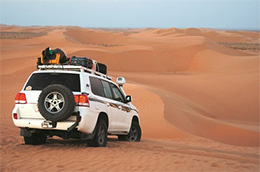 From Tan-Tan, the road follows an exciting itinerary through a crag on the edge of Sahara and ocean... The Naila salt lagoon, separated from the ocean by a rows of dunes, with an estuary on the sea, is the largest salt lake in Morocco (100 square Km). Protected area of great natural beauty is an important resting point on the birds migratory way, can host up to 20.000 individuals as flamingos, cormorants, gulls, herons… We will board a local fisherman boat to explore this emerald water enclosed in a large frame of yellow dunes and brown escarpments.
From Tan-Tan, the road follows an exciting itinerary through a crag on the edge of Sahara and ocean... The Naila salt lagoon, separated from the ocean by a rows of dunes, with an estuary on the sea, is the largest salt lake in Morocco (100 square Km). Protected area of great natural beauty is an important resting point on the birds migratory way, can host up to 20.000 individuals as flamingos, cormorants, gulls, herons… We will board a local fisherman boat to explore this emerald water enclosed in a large frame of yellow dunes and brown escarpments.
Late afternoon arrival at the small town of Tarfaya on the Juby Cape, less than 100 km away from the Canary Islands. Tarfaya is a former “Aeropostale” base, which pioneered airmail transport from Europe to Africa and Latin America, interesting museum. In Tarfaya, Saint Exupéry the famous aviator and writer, author of “The little prince” was familiar. Hotel Casamar, rooms with private facilities.
Day 9 & 10: Western Sahara: The Forbidden Track
In Laayoune we will meet our local guide, a nomad from a Sahrawi tribe who will lead us through three days of a total of-road desert expedition crossing from north to south the Western Sahara.
The former Spanish Sahara colony has been the site of a long war between the Polisario Armed Front and the Moroccan army. Presently, it is part of Morocco.
Since the second half of the seventies, due to this long “sand war,” this region has been off-limits to travelers. Until today no peace treaty has been signed, but a cease-fire is respected. We are proud to be the “first” to bring intrepid travelers to the vast, sandy regions of Saguia El Hamra and Tiris Zemmour. In this real Saharan expedition, we will cross large dunes to discover wells frequented by long lines of cammels belonging to the legendary Reguibat nomads. Days 9 and 10 camping under the stars of the desert.
Day 11: From the Desert to the Ocean
Our off-track Trans-Saharan expedition will cross regions of dunes, wells and nomadic camps. In the afternoon, a road will bring us to the ocean. Evening arrival at an hotel in Dakhla that will be our “base” for two nights. Hotel Doumss, air-conditioned rooms.
Day 12: Rio de Oro
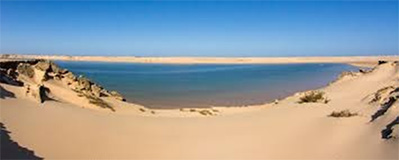 The exceptional beauty of this landscape makes the Dakhla peninsula a special place. The Rio de Oro is a 25-mile long sea loch situated between cliffs and dunes. Different pastel colours paint the scenery: the blue of the ocean, banks of yellow sand, and green seaweed fields and dark rocks. Thanks to a very high tide we will experience a unique scenery: the ocean will flood the desert and a white dune will become a temporary island. The small town of Dakhla was founded by Spanish navigators in 1502 and was called “Villa Cisneros.”
The exceptional beauty of this landscape makes the Dakhla peninsula a special place. The Rio de Oro is a 25-mile long sea loch situated between cliffs and dunes. Different pastel colours paint the scenery: the blue of the ocean, banks of yellow sand, and green seaweed fields and dark rocks. Thanks to a very high tide we will experience a unique scenery: the ocean will flood the desert and a white dune will become a temporary island. The small town of Dakhla was founded by Spanish navigators in 1502 and was called “Villa Cisneros.”
Visit of the traditional fishing harbor, lunch in an oyster farm, drive along the shore where the waves lap the sand dunes. Return to our hotel in Dakhla, dinner in a typical restaurant. Hotel Doumss, air –conditioned rooms.
Day 13: Border: A Line In The Sand
Our route continues following the cliff between the desert and the ocean. We follow the only open road going south.
A signboard indicate that we are crossing the “Tropic of Cancer”, at Guerguarat military post we will cross the southern border of Morocco, the only open frontier between Maghreb and Black Africa. After the formalities, we will cross a few miles of “no-man land” where different traffickers have made their base in new and old cars and trucks apparently abandoned. The no-man land is the unmarked border, a theoretical line in the desert that “divides nothing from nothing”. On the other side, the military post of Mauritania. Evening arrival to Nouadhibou. Comfortable **** hotel.
Day 14 & 15: Sahara Exploration
Early morning departure for two days of pure exploration. Thanks to the experience of our staff we will make or own itinerary tracing an unmarked path in the sand ocean of Inchiri region, one of the les known part of Mauritanian desert. To cross long ranges of dunes we will reduce the tire pressure. Gps, maps, compass will assist our land-navigation in an untouched geological universe. Our direction will follow parallel the dunes lines. The real desert give the impression to be on earth before the human times. “ Sahara experience”: what makes unique the desert are the endless empty spaces, the untamed sand. In the middle of the Inchiri we will discover traces of ancient human presence: stone tools, remain of potteries, silent witness of people that has lived there long time ago, before the desertification. We will find the nomadic isolated settlements when the landscape will become less dramatic and some rare graze will appear. These human encounters after the immense silence of the Sahara are intense, the nomads living on the side of the Inchiri are not used to tourist.
Two nights of mobile camp.
Day 16: Adrar: Dunes and Mountains
The even more scenic landscape of Mauritania: valleys, high mountains, yellow sand dunes with peaks of dark and red rock, lost adobe villages. Amatlich Erg (large dune basin) is one of the most beautiful dune ranges in the region. We will visit remotes oasis and hidden adobe villages.
Evening arrival to Chinguetti where we will spend three nights. Dinner and overnight in a cozy guest house built in traditional Mauritanian style, (or private residence).
Day 17: Chinguetti, The Oasis
Wikipedia :Chinguetti (Arabic: شنقيط Šenqīṭ) is a ksar or medieval trading centre in northern Mauritania, located on the Adrar Plateau east of Atar.
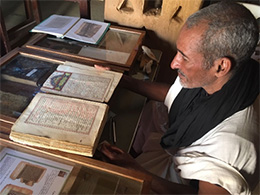 Founded in the 13th century as the center of several trans-Saharan trade routes, this small city continues to attract a handful of visitors who admire its spare architecture, scenery and ancient libraries. The city is seriously threatened by the encroaching desert; high sand dunes mark the western boundary and several houses have been abandoned to the sand.
Founded in the 13th century as the center of several trans-Saharan trade routes, this small city continues to attract a handful of visitors who admire its spare architecture, scenery and ancient libraries. The city is seriously threatened by the encroaching desert; high sand dunes mark the western boundary and several houses have been abandoned to the sand.
The indigenous Saharan architecture of older sectors of the city features houses constructed of reddish dry-stone and mud-brick techniques, with flat roofs timbered from palms. Many of the older houses feature hand-hewn doors cut from massive ancient acacia trees, which have long disappeared from the surrounding area. Many homes include courtyards or patios that crowd along narrow streets leading to the central mosque.
Notable buildings in the town include The Friday Mosque of Chinguetti, an ancient structure of dry-stone construction, featuring a square minaret capped with five ostrich egg finials; the former French Foreign Legion fortress. The old quarter of the Chinguetti has five important manuscript libraries of scientific and Qur'anic texts, with many dating from the later Middle Ages.
We will spend the whole day in the magical atmosphere of this village, which is considered the jewel of Mauritanian oasis, discovering two ancient manuscript collection, including Ould Habott, the largest in Mauritania. Return to our cozy guest house.
Day 18: Ouadane, the Remotest
We will drive to Ouadane in an absolute “out of any track” itinerary that follows the Ouadi (dry creek) discovering remote tiny oasis hidden in the high dunes. Entire day dedicated to discover Ouadane and his region, the remotest oasis in Mauritania, an outpost in the emptiest of the desert. Ouadane was founded in 1147. Mainly in ruin, some of his stone houses perched on a rocky hill surrounded by the immensity of Sahara are still inhabited. In the ancient days this town was an important caravan trading point between Maghreb and black Africa.
Trading was so flourishing that in 1487 Portuguese built a fortified trading counter in the region.
Retourn to our cosy base in Chinguetti.
Dinner and overnight at “La Gueila” (or private residence)
Day 19: Noukchott
Day driving on a large road in the desert. Evening arrival to Nouakchott the capital of Mauritania, a newer town surrounded by the desert. Dinner and overnight in the comfortable Halima hotel.
Day 20: Djoudj National Park
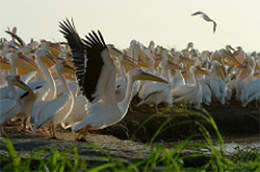 Early morning departure for the small border post with Senegal. The natural border between Mauritania and Senegal is the Senegal River; we will cross the river on a mobile bridge and we will move into a humid area isolated between desert and dry savannah.
The Djoudj National Park, declared a World Heritage Site, is a natural oasis formed by hundreds of miles of partially flooded lands. This “humid paradise” is the best habitat and nesting site of over a million migratory and sedentary birds.
Early morning departure for the small border post with Senegal. The natural border between Mauritania and Senegal is the Senegal River; we will cross the river on a mobile bridge and we will move into a humid area isolated between desert and dry savannah.
The Djoudj National Park, declared a World Heritage Site, is a natural oasis formed by hundreds of miles of partially flooded lands. This “humid paradise” is the best habitat and nesting site of over a million migratory and sedentary birds.
Wikipedia says: “The Djoudj National Bird Sanctuary (French: Parc National des Oiseaux du Djoudj) lies on the southeast bank of the Senegal River, north east of St-Louis. It offers a range of wetland habitats which are very popular with migratory birds, many of which have crossed the Sahara. Of almost 400 species, the most visible are the pelicans and the flamingos....” . We will enjoy a boat excursion to visit an island with an astonishing concentration of pelicans.
Arrival in the evening to Saint Louis. Dinner and overnight at “Hotel de la Poste”, a historical hotel built in 1850 and which used to be the base of the “Aeropostale” (airmail pioneer operation) pilots. Totally restored, it has conserved the best “hold colonial atmosphere” in town.
Day 21: Saint Louis, African And Colonial Citadels
Morning visit of Saint Louis, a charming old town and first capital of all French colonies in West Africa. The best way to get around the narrow streets of Saint Louis will be on board of the calash, like the locals do! A walk will complete the discovery of the local quarters. Departure in the late morning heading south for more than 100 Km driving on the beach between waves, seagulls and tiny fisherman villages. We will live the beach and cross ranges of dunes to reach Lampoul . Dinner and overnight in fancy fix camp, en-suite tents. Dinner at the restaurant on the dunes.
Day 22: From Fisherman Village to Contemporary Artists
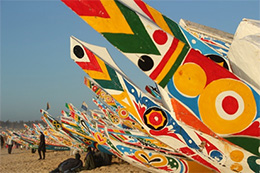 Spectacular long drive on a wild beach, between waves and sand to discover the largest fisherman village in Senegal, more than 4500 wooden pirogues came to the shore with the catch of the day… We will live our vehicles for a less intrusive, but fun, donkey chariot to approach the fisherman selling to the local market women, to meet the artisans craving the large pirogues, the painters decorating them with bright colours and the “local saint” for final magical blessing before sailing…. Lac Rose, also known as Lac Retba, is a shallow saltwater lake surrounded by dunes. The water is ten times saltier than the ocean and due to the high concentration of salt the lake often shimmers in pink; swimming in the lake gives the sensation of floating. More than 600 people work collecting salt from the lake, in the traditional way.
Spectacular long drive on a wild beach, between waves and sand to discover the largest fisherman village in Senegal, more than 4500 wooden pirogues came to the shore with the catch of the day… We will live our vehicles for a less intrusive, but fun, donkey chariot to approach the fisherman selling to the local market women, to meet the artisans craving the large pirogues, the painters decorating them with bright colours and the “local saint” for final magical blessing before sailing…. Lac Rose, also known as Lac Retba, is a shallow saltwater lake surrounded by dunes. The water is ten times saltier than the ocean and due to the high concentration of salt the lake often shimmers in pink; swimming in the lake gives the sensation of floating. More than 600 people work collecting salt from the lake, in the traditional way.
Arrival to Dakar, “Village des Arts” is composed by more of fifty workshops of contemporary artists. The Senegalese artistic scene has attracted artist from al the continent. We will meet the artist in their production site and discover their works that range from painting and sculpture and pottery to photography and filming.
Ferry to Gorée Island: The right time to enjoy Gorée is at sunset when all tourists are gone or in the morning before the crowd arrival.
Dinner in a typical restaurant and overnight at “Maison Municipal” or similar. A comfortable Guest house in an ancient, restored building.
Day 23: Dakar, African Metropolis
In Gorée island slaves were crammed, waiting to be shipped to the Americas. Totally restored remain to bear witness of those times. Today its breezy climate, history and ancient architecture, together with nice restaurants and boutiques, make Gorée an interesting and trendy destination for local and foreign visitors. Ferry to Dakar and visit of the town.
Dakar became an important centre of political, artistic and intellectual “renouveau” during the independence, and is still a lively African metropolis. Visit of the “Plateau” district, the Presidential Palace and a typical market. Late morning drive in south direction.
Dinner and Overnight at the comfortable air-conditioned bungalows of Kabacoto Safari Lodge, facing a lake in the savanna.
Day 24: Gambia, Betwin Archeology and Contemporaneity
Early departure, the region between the north bank of Gambia River and Senegal have hosted one of the largest megalithic civilisation. Sine Ngayene is the richest Megalitic site with 1102 erected stones. Border of Gambia and a “ very local” ferry crossing of the large Gambia River estuary to reach Banjul, the capital of the country.. Visit of the town centre, and the interesting national museum. Dinner and overnight at Atlantic hotel, full air-conditioned, swimming pool.
Day 25: Dancing Mask
Morning, brief but intense guided bird watching experience.
Departure for the border with Casamance, the southern region of Senegal.
Late afternoon we will join the ritual dances of Diola sacred mask. The masks belongs to a secret society and the identity of the dancers is not revealed, it is said that the mask is animated by the spirits. Drums, dances and a colourful crowd will enliven the tiny village in the shade of larges kapok trees.
Dinner and overnight at the comfortable Kadiandoumange hotel, located on the bank of Casamance large river, swimming pool.
Day 26: Ancestors Cult
Arrive to the border of Guinea Bissau. The Manjaco ethnic group calls the traditions “Gendiman”. We will visit tiny villages hidden in the forest to discover the sculptured wooden poles called “Pecab” that represent the spirits of their ancestors, in a sanctuary known as “Cab Balugun”. After asking permission to the villagers, we will have the opportunity to see different generations and styles of sacred wooden sculptures; one of the last chances to enjoy tribal art is its original cultural context. Dinner and overnight at the Hotel Banagam in Bula, basic but clean air-conditioned rooms.
Day 27: Bijagos Sacred Archipelago: Ghost Capital and Masks
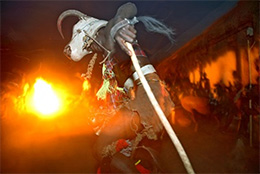 We will start a three days spectacular navigation on a speedboat to discover the Bijagos Archipelago, his fascinating nature and isolated tribes. The Archipelago, composed by 88 islands and islets, is located at an average of 40 miles from the coast line. Bijagos is a “geographical jewel”.
We will start a three days spectacular navigation on a speedboat to discover the Bijagos Archipelago, his fascinating nature and isolated tribes. The Archipelago, composed by 88 islands and islets, is located at an average of 40 miles from the coast line. Bijagos is a “geographical jewel”.
Bolama is the former capital of the Portuguese Guinea from 1871 to 1941 before the capital was moved to Bissau. When the Portuguese left, native people came to live in this town which is now falling apart, partly invaded with tropical vegetation. Built following the plans of a «Castrum Romane» (roman citadel) the town is made of straight large avenues, sunny and lethargic empty squares, dry fountains, bush-like gardens, imposing administrative buildings in neo Palladian style. In the shade of the columns at the former governor palace goats graze peacefully. Although inhabited, this capital town is plunged in the fairytale atmosphere of a ghost town.
Vaca Bruto (wild bull) is the most spectacular mask in the islands, the dancers convey the mask a realistic presence by bowing and facing the ground. With eyes of frosted glass, real horns, leather ears and a rope through the nostril. All convey the idea of a real untamed animal, representing a man in full possession of his physical strength but still with an immature behaviour as he has not yet undergone the final initiations. All the villagers attend this fascinating ceremony. Dinner and overnight at Orango Island, comfortable Eco-hotel with bungalows facing vegetation and ocean.
Day 28: Saltwater Hippos.
Orango Island, which is part of the Parque Natural of Orango, is covered by a savannah and is known for the presence of unique exemplars of “saltwater” hippos in Western Africa. These unique animals of an extremely rare behaviour live in the “saltwater” of the mangrove forests and “go for a swim” in the ocean. From October to the first part of February it is possible to follow their tracks. However, as they move around the island searching for ponds, it happens that local guides lose their tracks for days. Afternoon arrival to Rubane Island for a final relax. Dinner and overnight at the best resort in the archipelago. Large wooden bungalows hidden in the vegetation facing a wild beach, swimming pool, restaurant on stilts with refined French and local cuisine. Diner and Overnight at Ponta Anchaca.
Day 29: Bissau
Morning relax at Ponta Anchaca or optional visit of Bubaque, the islands lager village. Afternoon continue to Bissau. A vehicle will be waiting us for a city tour. Bissau is a tiny but intriguing capital town with old Portuguese architecture and a huge fort, a reminder of the slave trade era. In the evening, some day-rooms will be waiting for us in an hotel near Che Guevara Square, the liveliest district in town, for a last shower before the final transfer to the airport.
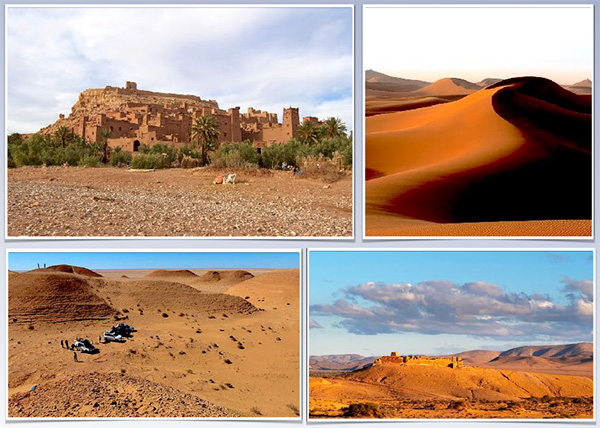
Morocco
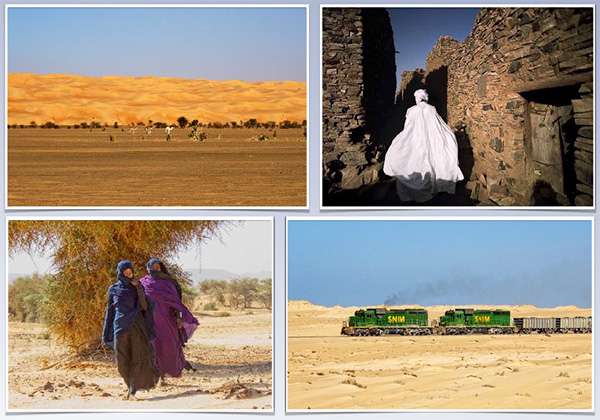
Sahara
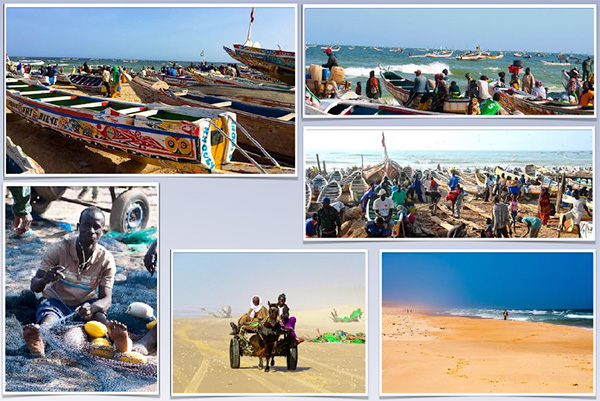
Senegal

Bijagos Archipelago
Full expedition:
29 days from Marrakech to Bissau
Departure from Marrakech November15th, 2019
-end in Bissau December 13th, 2019 evening.
The price includes:
- Full board, all meals from breakfast of the 2nd day to lunch of the 28th day.
- Participation to all traditional events, including mask dances and celebrations.
- Entrance fees in National parks, museums, and all visits included in the program.
Group of 9 or more participants: Public price € 7,696 -
Group of 6 to 8 participants: Public price € 8,094 -
Group of 5 participants: Public price € 8,593 -
SINGLE ROOM SUPPLEMENT: Public price € 998 -
Extention at Ponta Anchaca Lodge, Rubane island in Bijagos Archipelago
Ocean view air-conditioned bungalow, duration at your own choice:
Per person sharing a double bungalow in full board: 125 Euro par day.
Single room supplement 40 Euro par day.
Private panoramic flight to (or from) Bissau:
366 Euro / one way / group: 1-3 passengers.
120 Euro one way/ person / minimum 2 participants.
If you are a single passenger the hotel can try to find other passengers, please ask in advice.




